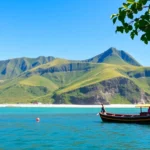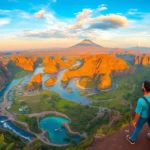Understanding Lombok: Geographical & Cultural Overview
Nestled in the heart of Indonesia’s Lesser Sunda Islands, Lombok stands out as a captivating destination renowned for its rich cultural tapestry, stunning landscapes, and vibrant local communities. As a part of the West Nusa Tenggara province, this island boasts a diverse array of natural wonders, traditional customs, and modern adventure opportunities that appeal to travelers, researchers, and cultural enthusiasts alike. With an approximate population of over 4 million residents, Lombok is not only geographically significant but also culturally vibrant, reflecting the deep-rooted traditions of its indigenous Sasak people and their unique heritage.
Location and Regional Significance of Lombok
Geographically, Lombok is separated from Bali by the Lombok Strait, a strategic waterway that underscores its importance in maritime connectivity and regional trade. The island spans an area of approximately 4,738 square kilometers and features a varied terrain that ranges from lush coastal plains to rugged mountainous regions. Its proximity to other significant islands, such as Sumbawa and Flores, positions Lombok as a vital component in the archipelago’s ecological and cultural network. The island’s strategic location and natural resources have historically made it a hub for trade, cultural exchange, and maritime activity, which continue to influence its economic development today.
Cultural Heritage and Traditional Elements
Lombok’s cultural landscape is characterized by its deeply embedded traditions, festivals, and art forms that have been preserved over centuries. The Sasak community, which forms the majority of the population, practices a unique blend of indigenous animist beliefs and Islamic faiths, resulting in colorful ceremonies and rituals such as Nyale fishing festivals and traditional weaving. The distinctive Sasak architecture, with its traditional rumah adat, showcases the craftsmanship and aesthetic principles passed down through generations. Local crafts, like wood carvings, textiles, and pottery, are not only cultural symbols but also vital economic activities that sustain artisan communities. Understanding Lombok’s cultural heritage is key to appreciating its identity and ongoing traditions.
Key Demographics and Local Communities
The demographics of Lombok reveal a predominantly Sasak population, complemented by a mosaic of ethnic groups, including Balinese, Sumbawa, and foreigners seeking cultural or adventure tourism. Urban centers such as Mataram, the provincial capital, serve as the administrative and economic hubs, while rural villages maintain the authenticity of traditional life. The majority of residents are involved in agriculture, fishing, and increasingly, tourism. The demographic trends indicate a youthful population with a growing number of younger entrepreneurs contributing to the local economy. This diversity fosters an environment of cultural exchange and innovation, making Lombok a dynamic society rooted in tradition yet open to change.
Top Attractions and Natural Wonders in Lombok
Beaches and Marine Activities
Lombok’s coastline is celebrated for its pristine beaches, crystal-clear waters, and world-class surf breaks. Destinations like Tanjung Aan, Senggigi Beach, and Selong Belanak attract surfers, snorkelers, and beach lovers year-round. The island’s marine environments are protected areas that teem with vibrant coral reefs, diverse fish species, and marine life, making it an excellent site for diving and snorkeling. Gili Islands—Gili Trawangan, Gili Air, and Gili Meno—are especially popular for their coral reefs, night snorkeling, and tranquil island atmospheres. These islands have become symbolized as eco-friendly havens that promote sustainable tourism associated with marine conservation efforts.
Mount Rinjani and Trekking Adventures
Standing at 3,726 meters, Mount Rinjani is Indonesia’s second-highest volcano and one of the most iconic landmarks of Lombok. Its caldera houses a stunning crater lake, Segara Anak, surrounded by lush forests and hot springs. Trekking to Rinjani’s summit offers challenging yet rewarding experiences for hikers, with routes varying from two to four days. Guided tours provide insights into volcanic activity, local flora, and fauna, and promote eco-friendly tourism practices. The Rinjani Trek is not only a test of endurance but also a journey through some of Indonesia’s most breathtaking natural scenery, attracting adventurers from around the world.
Unique Island and Marine Ecosystems
Beyond Rinjani and its well-known beaches, Lombok houses several lesser-known islands and marine ecosystems that demand exploration. The Gili Islands, for instance, serve as ecological hotspots, hosting endangered sea turtles, manta rays, and colorful coral gardens. Marine protected areas enhance biodiversity conservation, facilitating eco-tourism and scientific research. The island ecosystems support local livelihoods through sustainable fishing and diving industries, emphasizing the importance of environmental stewardship. These ecosystems exemplify Lombok’s commitment to balancing tourism growth with ecological preservation.
Travel Planning & Practical Tips for Visiting Lombok
Best Time to Visit & Climate Insights
Lombok enjoys a tropical climate with distinct dry and rainy seasons. The dry season, from May to September, is considered the peak travel period, offering ideal weather for outdoor activities, beaches, and trekking. The rainy season, typically from November to March, brings increased humidity and intermittent showers but also lower prices and fewer crowds. Understanding local weather patterns helps travelers plan their itineraries accordingly. The optimal time for visiting depends on preferences—adventure seekers favor the dry season, whereas cultural festivals and shopping may be more appealing during the off-peak months.
Transport Options and Accessibility
Reaching Lombok is accessible via Ngurah Rai International Airport in Bali, with frequent flights connecting to Lombok International Airport (airport code: LOP). Once on the island, transportation options include rental scooters, private cars, and public minibuses known as “bemos.” Ferry services connect Lombok to Bali and the Gili Islands, offering scenic routes across the sea. For exploring remote villages and attractions, hiring local guides or drivers ensures a smoother experience and deeper insights into niche destinations. Infrastructure development continues to improve, making Lombok increasingly accessible for international visitors.
Essential Travel Tips and Local Etiquette
Travelers should respect local customs, such as dressing modestly at religious sites and greeting locals with traditional gestures like hand gestures or greetings. Tipping is appreciated but not obligatory, usually around 5-10% in restaurants or for guide services. Using Bahasa Indonesia greetings enhances interactions with residents. It’s also vital to practice sustainable travel by avoiding single-use plastics, participating in community-led initiatives, and supporting local artisans and businesses. Being culturally sensitive and environmentally conscious enhances the travel experience while contributing positively to the island’s socio-economic fabric.
Experiencing Lombok’s Culture & Local Cuisine
Traditional Festivals and Art Forms
Cultural events in Lombok are vibrant displays of local heritage. The Nyale Festival, held annually during the full moon, celebrates the sea and harvests, featuring traditional boat races, dance performances, and communal feasting. Traditional Sasak music and dance, such as Gendang Beleq, showcase rhythmic percussion and storytelling. Artistic crafts like weaving ikat textiles, wood carvings, and silver jewelry reflect indigenous aesthetics and craftsmanship. Visitors can participate in cultural workshops or visit local villages during festivals, gaining insight into the rich traditions that define Lombok’s identity.
Local Culinary Delights and Food Markets
Lombok’s cuisine is characterized by its bold flavors, aromatic spices, and fresh ingredients. Signature dishes include Ayam Taliwang—spicy grilled chicken served with rice—and Plecing Kangkung, a vegetable salad with chili and lime dressing. Seafood is abundant and often prepared simply to highlight freshness. Traditional markets like Pasar Cakranegara offer local delicacies, herbs, and ingredients that reflect the island’s culinary diversity. Sampling local foods supports small vendors and artisans, adding authenticity to travel experiences.
Handicrafts and Souvenir Shopping
Artisans in Lombok craft a variety of souvenirs rooted in cultural traditions. Tenganan-style ikat textiles, carved wooden masks, and silver jewelry are popular among travelers. Many local markets and cooperatives promote fair trade practices, ensuring artisans receive equitable compensation. Visiting craft villages like Sukarara provides opportunities for hands-on experiences, allowing visitors to learn traditional weaving techniques firsthand. Supporting these local crafts sustains cultural heritage and boosts local economies.
Future Trends and Sustainable Tourism in Lombok
Community-Led Tourism Initiatives
Recognizing the importance of local involvement, many organizations and government programs are promoting community-led tourism. These initiatives empower residents to manage and benefit from tourism activities, thus fostering sustainable economic growth. Examples include homestay programs, cultural tours led by local guides, and eco-tourism projects aimed at preserving natural and cultural assets. Such efforts not only ensure authentic experiences for visitors but also promote social equity within local communities.
Ecotourism and Environmental Conservation
Environmental preservation is a core focus for Lombok’s future development. Protected marine parks, reforestation projects, and plastic waste reduction campaigns are actively promoted. Eco-certification standards for resorts and tour operators are encouraging responsible practices. Visitors can participate in coral reef restoration, wildlife observation, and organic farming tours. Implementing eco-friendly infrastructure and stewardship practices ensures Lombok’s natural beauty remains resilient for future generations.
How Visitors Can Support Responsible Travel
Responsible travelers contribute to conservation, cultural integrity, and local livelihoods by choosing eco-friendly accommodation, minimizing plastic waste, and supporting community enterprises. Engaging with local guides, buying handmade crafts, and participating in conservation activities enhance sustainable development. Educating oneself about Lombok’s environmental and cultural issues prior to travel encourages mindful behavior, ensuring that tourism remains a positive force for the island’s enduring vitality.








